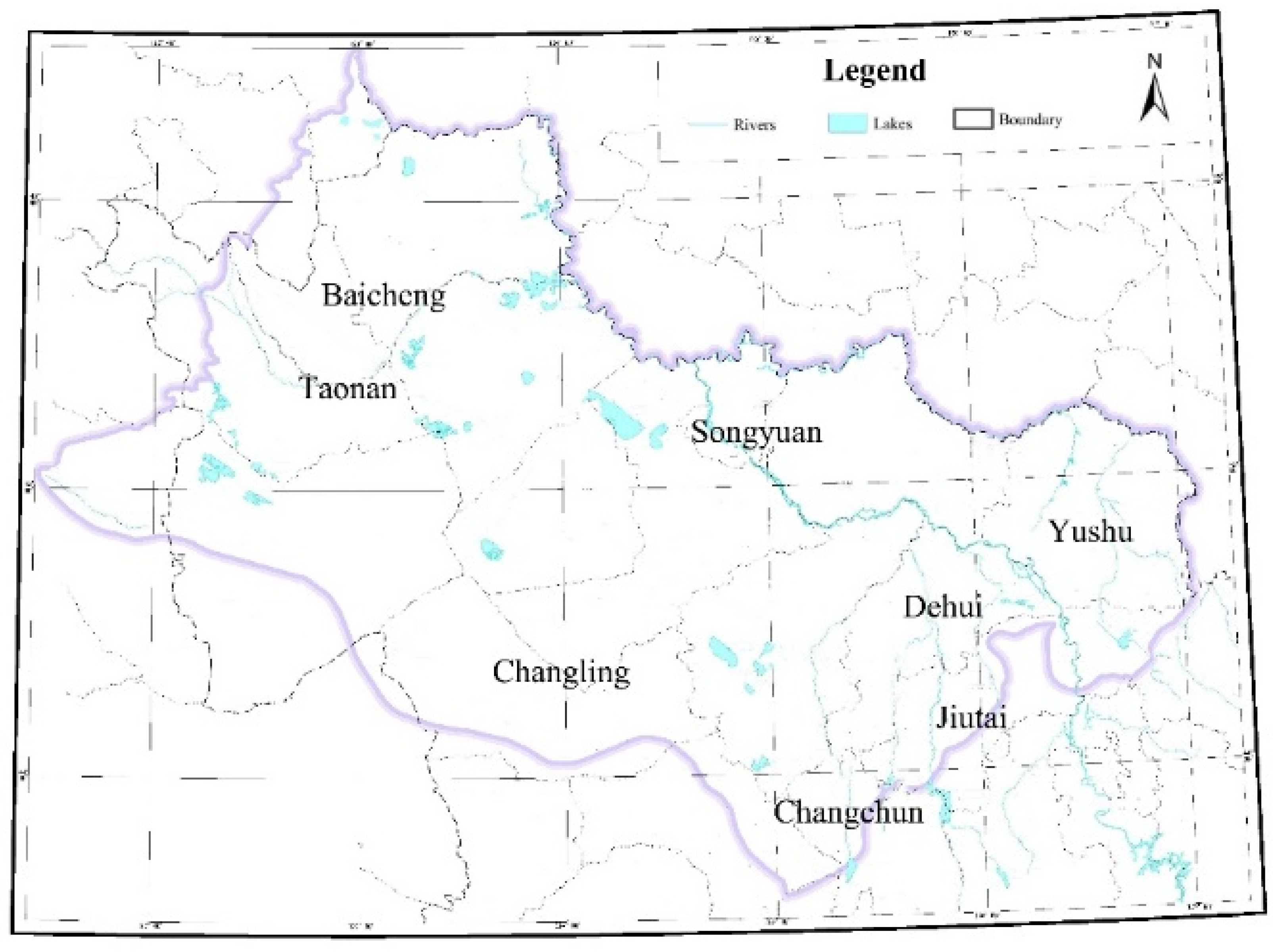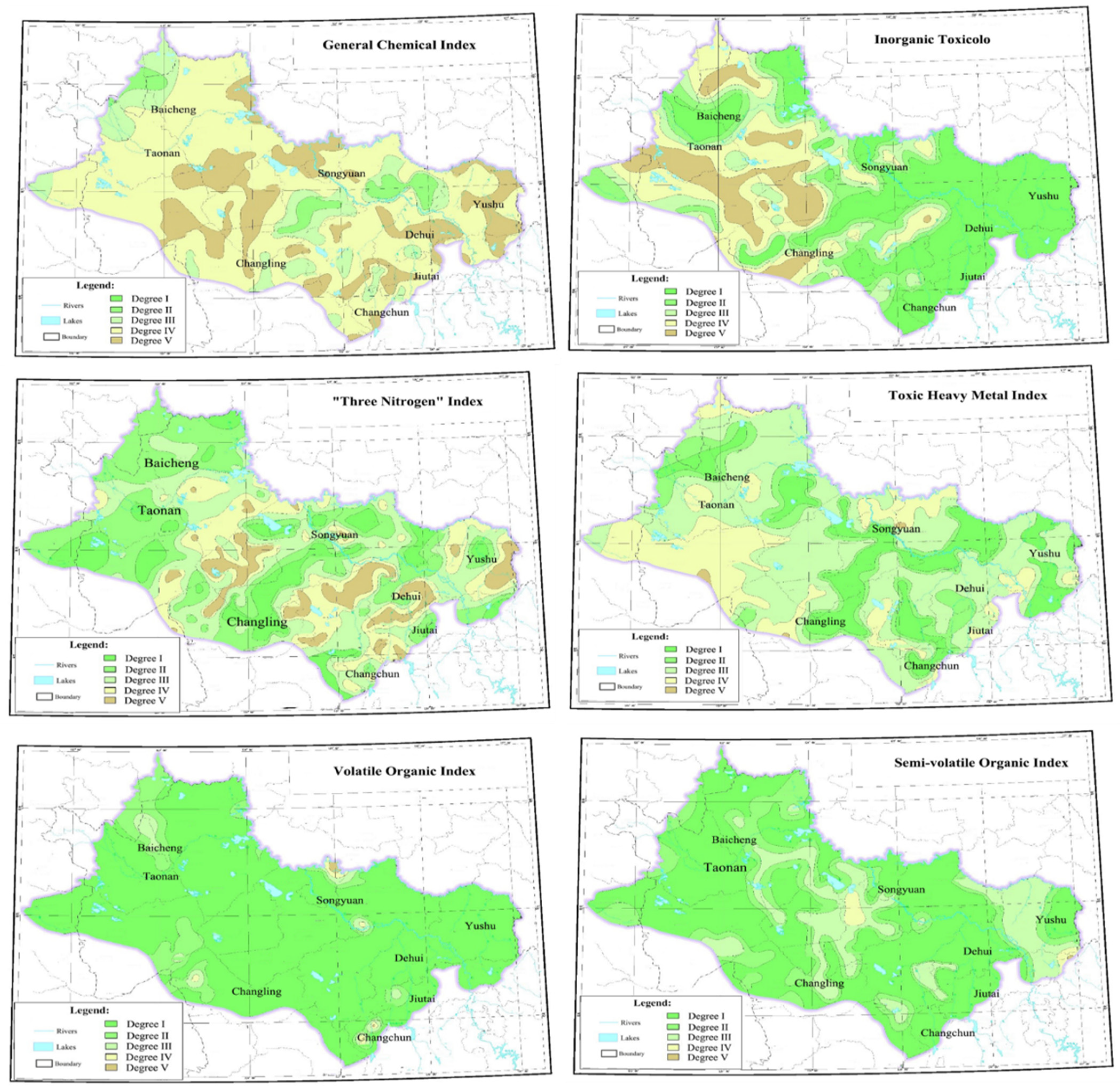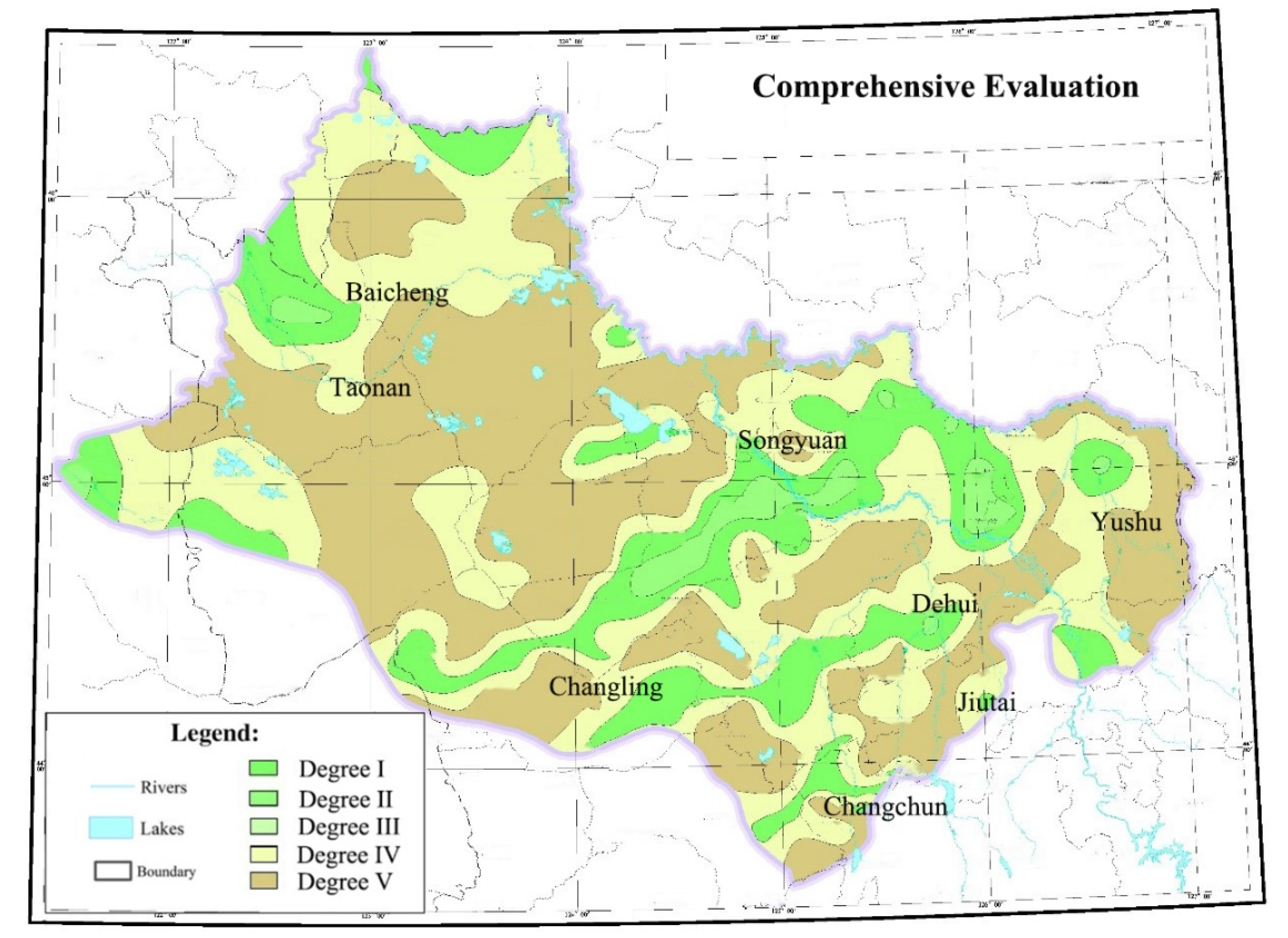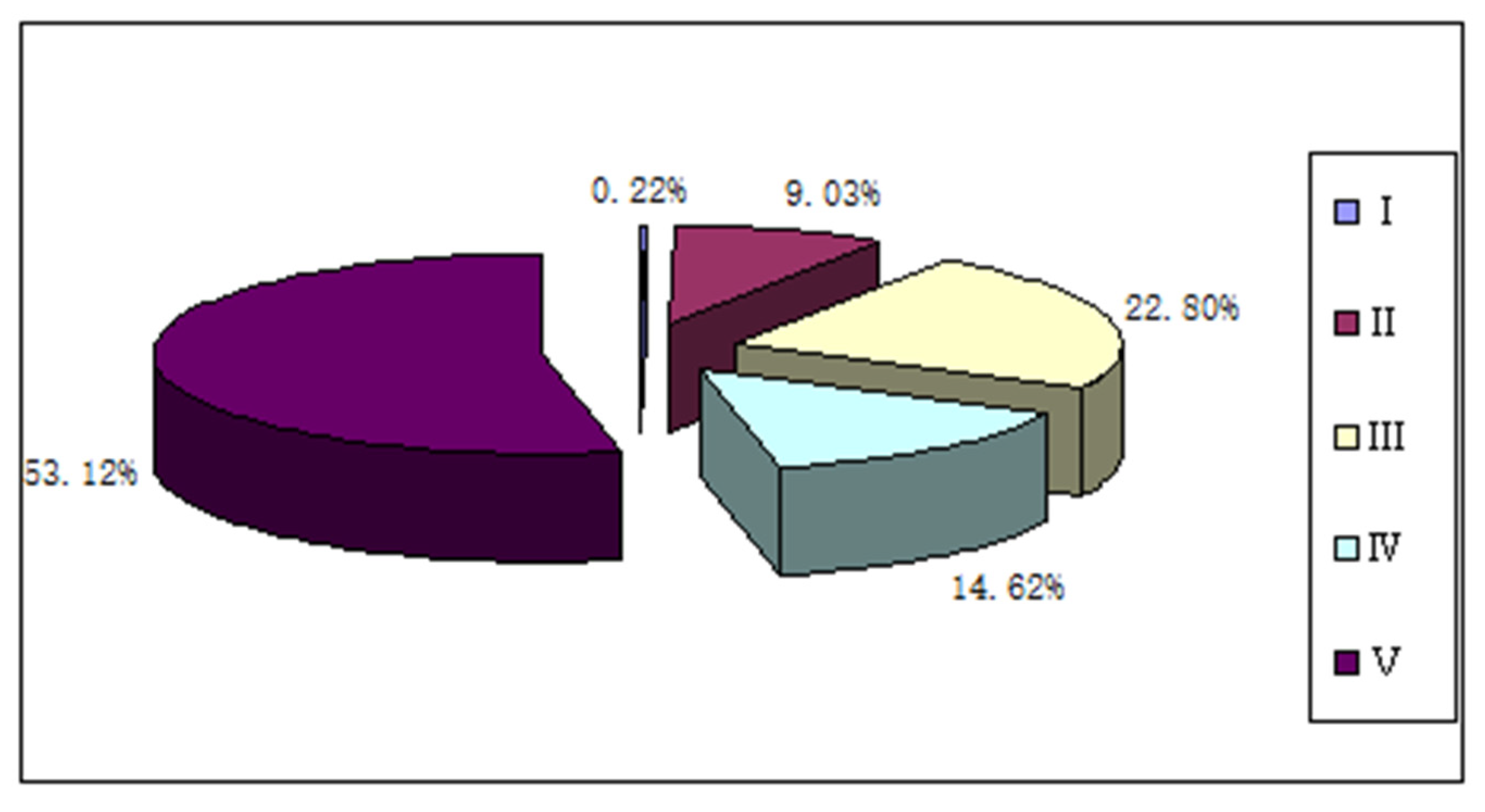Assessment of Groundwater Quality and Pollution in the Songnen Plain of Jilin Province, Northeast China
Abstract
:1. Introduction
- To analyze the present situation of groundwater pollution index and the distribution of pollution levels in the groundwater.
- To explore the characteristics of the physico-chemical elements of groundwater and assess its suitability for drinking and irrigation purposes.
- To assess the state of pollution by using various pollution assessment methods.
2. Materials and Methods
2.1. Study Area
2.2. Groundwater Sampling and Analysis
2.3. Groundwater Quality Assessment
2.3.1. Groundwater Pollution Index
2.3.2. Multi-Index Classification of Groundwater
2.3.3. Fuzzy Comprehensive Evaluation
3. Results
4. Discussion
4.1. Single Index Quality Assessment
4.2. Multi-Indicator Evaluation
4.3. Comprehensive Quality Assessment
4.4. Influence Index of Groundwater Quality
5. Conclusions
- The main elements exceeding the standard in groundwater are Al, TH, TDS, Mn, As, NO3−, Fe, F−, volatile phenol, and BaP.
- The proportions of classes IV and V in the other indices were less than 10%. The most important factors affecting groundwater quality were general chemical indexes, followed by inorganic toxicology and heavy metals; the three evaluated forms of nitrogen, volatile organic compounds, and semi-volatile organic compounds had little influence on groundwater quality.
- The three nitrogen results are mainly related to human activities: the more intense the human activity, the more significantly the "three nitrogen" standard is exceeded. TH and TDS are related to the original environment and groundwater overmining.
- The detection and removal of organic components also exhibit a strong relationship with human activity.
- The results of the comprehensive quality assessment show that the groundwater quality in this area is generally poor, which is influenced by both the original environment and human activities.
- improve well construction processes to avoid cross-bedding pollution;
- carefully select materials used to build wells to avoid contamination;
- protect the environment of the wellhead from pollution;
- avoid pollution caused by overexploitation;
- regulate agricultural activities and sewage discharge;
- implement a strict water source protection system and prohibit groundwater pollution in protection areas.
Author Contributions
Funding
Institutional Review Board Statement
Informed Consent Statement
Data Availability Statement
Acknowledgments
Conflicts of Interest
Abbreviations
References
- Wu, J.; Bian, J.; Wan, H.; Ma, Y.; Sun, X. Health risk assessment of groundwater nitrogen pollution in Songnen Plain. Ecotoxicol. Environ. Saf. 2021, 207, 111245. [Google Scholar] [CrossRef]
- Alikhanov, B.; Juliev, M.; Alikhanova, S.; Mondal, I. Assessment of influencing factor method for delineation of groundwater potential zones with geospatial techniques. Case study of Bostanlik district, Uzbekistan. Groundw. Sustain. Dev. 2021, 12, 100548. [Google Scholar] [CrossRef]
- Mukherjee, A.; Sarkar, S.; Chakraborty, M.; Duttagupta, S.; Bhattacharya, A.; Saha, D.; Bhattacharya, P.; Mitra, A.; Gupta, S. Occurrence, predictors and hazards of elevated groundwater arsenic across India through field observations and regional-scale AI-based modeling. Sci. Total Environ. 2021, 759, 143511. [Google Scholar] [CrossRef]
- May, R.; Mazlan, N.S.B. Numerical simulation of the effect of heavy groundwater abstraction on groundwater–surface water interaction in Langat Basin, Selangor, Malaysia. Environ. Earth Sci. 2014, 71, 1239–1248. [Google Scholar] [CrossRef]
- Ahmed, I.; Tariq, N.; Al Muhery, A. Hydrochemical characterization of groundwater to align with sustainable development goals in the Emirate of Dubai, UAE. Environ. Earth Sci. 2019, 78, 44. [Google Scholar] [CrossRef]
- Eslami, F.; Yaghmaeian, K.; Mohammadi, A.; Salari, M.; Faraji, M. An integrated evaluation of groundwater quality using drinking water quality indices and hydrochemical characteristics: A case study in Jiroft, Iran. Environ. Earth Sci. 2019, 78, 314. [Google Scholar] [CrossRef]
- Yuan, Y.; Liu, Y.; Luo, K.; Shahid, M.Z. Hydrochemical characteristics and a health risk assessment of the use of river water and groundwater as drinking sources in a rural area in Jiangjin District, China. Environ. Earth Sci. 2020, 79, 160. [Google Scholar] [CrossRef]
- Xu, B.; Liu, S.; Zhou, J.L.; Zheng, C.; Weifeng, J.; Chen, B.; Zhang, T.; Qiu, W. PFAS and their substitutes in groundwater: Occurrence, transformation and remediation. J. Hazard. Mater. 2021, 412, 125159. [Google Scholar] [CrossRef] [PubMed]
- Li, P.; Wu, J.; Qian, H.; Zhang, Y.; Yang, N.; Jing, L.; Yu, P.; Li, P.; Qian, H. Hydrogeochemical Characterization of Groundwater in and Around a Wastewater Irrigated Forest in the Southeastern Edge of the Tengger Desert, Northwest China. Expo. Health 2016, 8, 331–348. [Google Scholar] [CrossRef]
- Liu, J.; Peng, Y.; Li, C.; Gao, Z.; Chen, S. A characterization of groundwater fluoride, influencing factors and risk to human health in the southwest plain of Shandong Province, North China. Ecotoxicol. Environ. Saf. 2021, 207, 111512. [Google Scholar] [CrossRef] [PubMed]
- Loh, Y.S.A.; Akurugu, B.A.; Manu, E.; Aliou, A. Assessment of groundwater quality and the main controls on its hydrochemistry in some Voltaian and basement aquifers, northern Ghana. Groundw. Sustain. Dev. 2020, 10, 100296. [Google Scholar] [CrossRef]
- Verma, A.; Yadav, B.K.; Singh, N.B. Hydrochemical exploration and assessment of groundwater quality in part of the Ganga-Gomti Fluvial Plain in northern India. Groundw. Sustain. Dev. 2021, 13, 100560. [Google Scholar] [CrossRef]
- Zakaria, N.; Anornu, G.; Adomako, D.; Owusu-Nimo, F.; Gibrilla, A. Evolution of groundwater hydrogeochemistry and assessment of groundwater quality in the Anayari catchment. Groundw. Sustain. Dev. 2021, 12, 100489. [Google Scholar] [CrossRef]
- Hua, K.; Xiao, J.; Li, S.; Li, Z. Analysis of hydrochemical characteristics and their controlling factors in the Fen River of China. Sustain. Cities Soc. 2020, 52, 101827. [Google Scholar] [CrossRef]
- Liu, J.; Gao, Z.; Wang, Z.; Xu, X.; Su, Q.; Wang, S.; Qu, W.; Xing, T. Hydrogeochemical processes and suitability assessment of groundwater in the Jiaodong Peninsula, China. Environ. Monit. Assess 2020, 192, 384. [Google Scholar] [CrossRef]
- Yousefi, M.; Ghoochani, M.; Hossein Mahvi, A. Health risk assessment to fluoride in drinking water of rural residents living in the Poldasht city, Northwest of Iran. Ecotoxicol. Environ. Saf. 2018, 148, 426–430. [Google Scholar] [CrossRef] [PubMed]
- Sambito, M.; Severino, A.; Freni, G.; Neduzha, L. A Systematic Review of the Hydrological, Environmental and Durability Performance of Permeable Pavement Systems. Sustainability 2021, 13, 4509. [Google Scholar] [CrossRef]
- Vu, T.; Ni, C.; Li, W.; Truong, M.; Marko Hsu, S. Predictions of groundwater vulnerability and sustainability by an integrated index-overlay method and physical-based numerical model. J. Hydrol. 2021, 596, 126082. [Google Scholar] [CrossRef]
- Dippong, T.; Mihali, C.; Hoaghia, M.; Cical, E.; Cosma, A. Chemical modeling of groundwater quality in the aquifer of Seini town—Someș Plain, Northwestern Romania. Ecotoxicol. Environ. Saf. 2019, 168, 88–101. [Google Scholar] [CrossRef] [PubMed]
- Ji, Y.; Wu, J.; Wang, Y.; Elumalai, V.; Subramani, T. Seasonal Variation of Drinking Water Quality and Human Health Risk Assessment in Hancheng City of Guanzhong Plain, China. Expo. Health 2020, 12, 469–485. [Google Scholar] [CrossRef]
- Nawale, V.P.; Malpe, D.B.; Marghade, D.; Yenkie, R. Non-carcinogenic health risk assessment with source identification of nitrate and fluoride polluted groundwater of Wardha sub-basin, central India. Ecotoxicol. Environ. Saf. 2021, 208, 111548. [Google Scholar] [CrossRef] [PubMed]
- Zuo, R.; Liu, X.; Zhang, Q.; Wang, J.; Yang, J.; Teng, Y.; Chen, X.; Zhai, Y. Sulfonamide antibiotics in groundwater and their migration in the vadose zone: A case in a drinking water resource. Ecol. Eng. 2021, 162, 106175. [Google Scholar] [CrossRef]
- Kwon, E.; Park, J.; Park, W.; Kang, B.; Woo, N.C. Nitrate contamination of coastal groundwater: Sources and transport mechanisms along a volcanic aquifer. Sci. Total Environ. 2021, 768, 145204. [Google Scholar] [CrossRef]
- Meng, L.; Zuo, R.; Wang, J.; Li, Q.; Du, C.; Liu, X.; Chen, M. Response of the redox species and indigenous microbial community to seasonal groundwater fluctuation from a typical riverbank filtration site in Northeast China. Ecol. Eng. 2021, 159, 106099. [Google Scholar] [CrossRef]
- Ouhamdouch, S.; Bahir, M.; Ouazar, D.; Carreira, P.M.; Zouari, K. Evaluation of climate change impact on groundwater from semi-arid environment (Essaouira Basin, Morocco) using integrated approaches. Environ. Earth Sci. 2019, 78, 1–14. [Google Scholar] [CrossRef]
- Liu, J.; Peng, Y.; Li, C.; Gao, Z.; Chen, S. Characterization of the hydrochemistry of water resources of the Weibei Plain, Northern China, as well as an assessment of the risk of high groundwater nitrate levels to human health. Environ. Pollut. 2021, 268, 115947. [Google Scholar] [CrossRef]
- Umamageswari, T.S.R.; Sarala Thambavani, D.; Liviu, M. Hydrogeochemical processes in the groundwater environment of Batlagundu block, Dindigul district, Tamil Nadu: Conventional graphical and multivariate statistical approach. Appl. Water Sci. 2019, 9, 14. [Google Scholar] [CrossRef] [Green Version]
- Giri, S. Water quality prospective in Twenty First Century: Status of water quality in major river basins, contemporary strategies and impediments: A review. Environ. Pollut. 2021, 271, 116332. [Google Scholar] [CrossRef]
- Marghade, D. Detailed geochemical assessment & indexing of shallow groundwater resources in metropolitan city of Nagpur (western Maharashtra, India) with potential health risk assessment of nitrate enriched groundwater for sustainable development. Geochemistry 2020, 80, 125627. [Google Scholar]
- Chen, R.; Teng, Y.; Chen, H.; Hu, B.; Yue, W. Groundwater pollution and risk assessment based on source apportionment in a typical cold agricultural region in Northeastern China. Sci. Total Environ. 2019, 696, 133972. [Google Scholar] [CrossRef]
- Yan, J.; Chen, J.; Zhang, W. Study on the groundwater quality and its influencing factor in Songyuan City, Northeast China, using integrated hydrogeochemical method. Sci. Total Environ. 2021, 773, 144958. [Google Scholar] [CrossRef]
- Bao, K.; Zaccone, C.; Tao, Y.; Wang, J.; Shen, J.; Zhang, Y. Source apportionment of priority PAHs in 11 lake sediment cores from Songnen Plain, Northeast China. Water Res. 2020, 168, 115158. [Google Scholar] [CrossRef] [PubMed]
- Mackenzie, L.; Bao, K.; Mao, L.; Klamt, A.; Pratte, S.; Shen, J. Anthropogenic and climate-driven environmental change in the Songnen Plain of northeastern China over the past 200 years. Palaeogeogr. Palaeoclimatol. Palaeoecol. 2018, 511, 208–217. [Google Scholar] [CrossRef]
- Qiu, X.; Zhang, L.; Wenliang, L.; Yang, Y.; Tao, P. Studies on changes and cause of the minimum air temperature in Songnen Plain of China during 1961–2010. Acta Ecol. Sin. 2016, 36, 311–320. [Google Scholar] [CrossRef]
- Du, Y.; Song, K.; Liu, G.; Wen, Z.; Fang, C.; Shang, Y.; Zhao, F.; Wang, Q.; Du, J.; Zhang, B. Quantifying total suspended matter (TSM) in waters using Landsat images during 1984–2018 across the Songnen Plain, Northeast China. J. Environ. Manag. 2020, 262, 110334. [Google Scholar] [CrossRef] [PubMed]
- Guo, H.; Zhang, D.; Wen, D.; Wu, Y.; Ni, P.; Jiang, Y.; Guo, Q.; Li, F.; Zheng, H.; Zhou, Y. Arsenic mobilization in aquifers of the southwest Songnen basin, China: Evidences from chemical and isotopic characteristics. Sci. Total Environ. 2014, 490, 590–602. [Google Scholar] [CrossRef]
- Zhang, B.; Song, X.; Zhang, Y.; Han, D.; Tang, C.; Yang, L.; Wang, Z. The relationship between and evolution of surface water and groundwater in Songnen Plain, Northeast China. Environ. Earth Sci. 2015, 73, 8333–8343. [Google Scholar] [CrossRef]
- Zhai, Y.; Zhao, X.; Teng, Y.; Li, X.; Zhang, J.; Wu, J.; Zuo, R. Groundwater nitrate pollution and human health risk assessment by using HHRA model in an agricultural area, NE China. Ecotoxicol. Environ. Saf. 2017, 137, 130–142. [Google Scholar] [CrossRef]
- Bian, J.; Nie, S.; Wang, R.; Wan, H.; Liu, C. Hydrochemical characteristics and quality assessment of groundwater for irrigation use in central and eastern Songnen Plain, Northeast China. Environ. Monit. Assess. 2018, 190, 382. [Google Scholar] [CrossRef]
- Yin, X.; Ma, C.; He, H.; Wang, Z.; Li, X.; Fu, G.; Liu, J.; Zheng, Y. Distribution and diversity patterns of soil fauna in different salinization habitats of Songnen Grasslands, China. Appl. Soil Ecol. 2018, 123, 375–383. [Google Scholar] [CrossRef]
- Liu, J.; Peng, Y.; Li, C.; Gao, Z.; Chen, S. An investigation into the hydrochemistry, quality and risk to human health of groundwater in the central region of Shandong Province, North China. J. Clean. Prod. 2021, 282, 125416. [Google Scholar] [CrossRef]
- Apaydin, A. Malibogazi groundwater dam: An alternative model for semi-arid regions of Turkey to store and save groundwater. Environ. Earth Sci. 2009, 59, 339–345. [Google Scholar] [CrossRef]
- Li, X.; Li, J.; Xi, B.; Yuan, Z.; Zhu, X.; Zhang, X. Effects of groundwater level variations on the nitrate content of groundwater: A case study in Luoyang area, China. Environ. Earth Sci. 2015, 74, 3969–3983. [Google Scholar] [CrossRef]
- Wu, M.; Feng, Q.; Wen, X.; Yin, Z.; Yang, L.; Sheng, D. Deterministic Analysis and Uncertainty Analysis of Ensemble Forecasting Model Based on Variational Mode Decomposition for Estimation of Monthly Groundwater Level. Water 2021, 13, 139. [Google Scholar] [CrossRef]
- State Environmental Protection Administration. Technical Specification for Environmental Monitoring of Groundwater, HJ/T 164-2004; China Quality and Standards Publishing & Media Co., Ltd.: Beijing, China, 2004. [Google Scholar]
- Standardization Administration of China. Standard for Groundwater Quality, GB/T 14848-2017; China Quality and Standards Publishing & Media Co., Ltd.: Beijing, China, 2017. [Google Scholar]
- Jiang, Y.; Gui, H.; Yu, H.; Wang, M.; Fang, H.; Wang, C.; Chen, C.; Zhang, Y.; Huang, Y. Hydrochemical Characteristics and Water Quality Evaluation of Rivers in Different Regions of Cities: A Case Study of Suzhou City in Northern Anhui Province, China. Water 2020, 12, 950. [Google Scholar] [CrossRef] [Green Version]
- Dahiya, S.; Singh, B.; Gaur, S.; Garg, V.K.; Kushwaha, H.S. Analysis of groundwater quality using fuzzy synthetic evaluation. J. Hazard. Mater. 2007, 147, 938–946. [Google Scholar] [CrossRef]
- Ha, K.; Lee, E.; An, H.; Kim, S.; Park, C.; Kim, G.; Ko, K. Evaluation of Seasonal Groundwater Quality Changes Associated with Groundwater Pumping and Level Fluctuations in an Agricultural Area, Korea. Water 2021, 13, 51. [Google Scholar] [CrossRef]
- Mastrocicco, M.; Colombani, N. The Issue of Groundwater Salinization in Coastal Areas of the Mediterranean Region: A Review. Water 2021, 13, 90. [Google Scholar] [CrossRef]
- Contreras, J.I.; Roldán-Cañas, J.; Moreno-Pérez, M.F.; Gavilán, P.; Lozano, D.; Baeza, R. Distribution Uniformity in Intensive Horticultural Systems of Almería and Influence of the Production System and Water Quality. Water 2021, 13, 233. [Google Scholar] [CrossRef]




| Degree | Description |
|---|---|
| I | Groundwater has low chemical content and is suitable for various uses in principle |
| II | Groundwater has slightly low chemical content and is suitable for various uses in principle |
| III | It is suitable for drinking, agricultural, and main industrial water |
| IV | It is suitable for agriculture and some industrial water and can be used as drinking water after proper treatment |
| V | Not suitable for drinking water, other water can be selected according to the purpose of use |
| Indicator Categories | Index Name |
|---|---|
| General Chemical Index | pH, Fe, Mn, Cu, Zn, Al, Cl−, SO42−, TH, TDS, COD, Na+ |
| Inorganic Toxicology Index | Fluoride, Se, Cyanide |
| “Three Nitrogen” Index | NH4+, NO3−, NO2− |
| Toxic Heavy Metal Index | As, Hg, Cr6+, Cd, Pb |
| Volatile Organic Index | Trichloromethane, Tetrachloromethane, 1, 1, 1-Trichloroethane, Trichloroethylene, Tetrachloroethylene, Dichloromethane, 1, 2- Dichloroethane, Bromoform, Chloroethylene, 1, 1-Dichloroethylene, 1, 2-Dichloroethylene, Chlorobenzene, Benzene, Methylbenzene, Ethylbenzene, Xylene, Styrene |
| Semi-Volatile Organic Index | HCH, γ-BHC, DDT, Hexachlorobenzene, BaP |
| Parameters | Min | Max | Class I (%) | Class II (%) | Class III (%) | Class IV (%) | Class V (%) |
|---|---|---|---|---|---|---|---|
| PH | 6.9 mg/L | 9.19 mg/L | – | – | 92.04 | 7.53 | 0.43 |
| Al | – | 2.56 mg/L | 34.84 | 21.94 | 24.95 | 14.62 | 3.66 |
| Fe | – | 48.93 mg/L | 25.38 | 20.86 | 8.17 | 35.7 | 9.89 |
| Mn | – | 9.84 mg/L | 42.37 | – | 6.67 | 46.24 | 4.73 |
| Cu | – | 12.03 mg/L | 93.98 | 5.38 | 0.22 | 0.22 | 0.22 |
| Zn | – | 90.93 mg/L | 87.96 | 11.18 | – | 0.43 | 0.43 |
| Cl− | 0.89 mg/L | 744.45 mg/L | 52.9 | 28.17 | 12.26 | 3.87 | 2.8 |
| SO42− | – | 846.07 mg/L | 69.46 | 21.72 | 5.81 | 1.51 | 1.51 |
| TH | 7.77 mg/L | 1650.48 mg/L | 6.88 | 43.23 | 25.16 | 15.05 | 9.68 |
| TDS | 23 mg/L | 3767 mg/L | 4.09 | 25.38 | 43.01 | 24.52 | 3.01 |
| COD | 0.24 mg/L | 9.23 mg/L | 47.74 | 33.98 | 10.32 | 7.96 | – |
| As | – | 0.96 mg/L | 34.41 | – | 47.31 | 15.7 | 2.58 |
| Cd | – | 0.03 mg/L | 91.61 | 7.31 | 0.43 | 0.22 | 0.43 |
| Cr6+ | – | 0.006 mg/L | 99.35 | 0.65 | – | – | – |
| Pb | – | 1.545 mg/L | 92.04 | – | 4.3 | 3.01 | 0.65 |
| Hg | – | 0.014 mg/L | 90.11 | – | 8.17 | 1.51 | 0.22 |
| Se | – | 0.0263 mg/L | 99.57 | – | – | 0.43 | – |
| Cyanide | – | 0.011 mg/L | 99.57 | 0.22 | 0.22 | – | – |
| F− | 0.17 mg/L | 10.43 mg/L | 0.43 | 30.75 | 31.40 | 16.77 | 20.65 |
| NO3− | – | 1000 mg/L | 41.29 | 15.48 | 18.06 | 6.67 | 18.49 |
| Trichloromethane | – | 30.88 μg/L | 99.35 | 0.22 | 0.43 | – | – |
| Tetrachloromethane | – | 46.67 μg/L | 99.57 | – | 0.22 | 0.22 | – |
| NH4+ | – | 6 mg/L | 83.23 | 1.08 | 7.1 | 5.59 | 3.01 |
| Na+ | 1.26 mg/L | 855 mg/L | 89.03 | – | – | 6.24 | 4.73 |
| NO2− | – | 10 mg/L | 79.14 | 15.05 | 5.38 | 0.43 | |
| Trichloroethylene | – | 69.89 μg/L | 99.57 | 0.22 | 0.22 | – | – |
| Dichloromethane | – | 1.03 μg/L | 99.78 | 0.22 | – | – | – |
| 1, 2- Dichloroethane | – | 705.50 μg/L | 98.71 | 0.43 | 0.22 | – | 0.65 |
| Benzene | – | 4.1 μg/L | 99.35 | – | 0.65 | – | – |
| Methylbenzene | – | 6.69 μg/L | 95.48 | 4.52 | – | – | – |
| Xylene | – | 0.76 μg/L | 99.78 | 0.22 | – | – | – |
| HCH | – | 163.86 μg/L | 97.42 | 1.08 | 0.22 | 0.43 | 0.86 |
| γ-BHC | – | 13.99 μg/L | 99.57 | 0.22 | – | 0.22 | – |
| DDT | – | 0.03476 μg/L | 99.57 | 0.43 | – | – | – |
| Hexachlorobenzene | – | 0.0047 μg/L | 100 | – | – | – | – |
| BaP | 0 | 1.189 μg/L | 73.76 | – | 9.89 | 15.27 | 1.08 |
| Indicator Categories | Ⅰ | Ⅱ | Ⅲ | Ⅳ | Ⅴ | |
|---|---|---|---|---|---|---|
| Semi-Volatile Organic Index | Area | 39,739.02 | 12,485.85 | 10,407.4 | 727.4 | 15.04 |
| Ratio | 62.7 | 19.71 | 16.42 | 1.15 | 0.02 | |
| Volatile Organic Index | Area | 56,253.03 | 5365.71 | 1383.76 | 271.82 | 97.91 |
| Ratio | 88.77 | 8.47 | 2.18 | 0.43 | 0.15 | |
| Toxic Heavy Metal Index | Area | 11,170.02 | 8063.06 | 30,478 | 13,472.79 | 190.86 |
| Ratio | 17.63 | 12.72 | 48.09 | 21.26 | 0.3 | |
| “Three Nitrogen” Index | Area | 7732.12 | 20,058.6 | 17,914.05 | 12,235.88 | 5434.09 |
| Ratio | 12.2 | 31.65 | 28.27 | 19.31 | 8.57 | |
| Inorganic Toxicology Index | Area | 25,157.73 | 8669.12 | 9009.44 | 13,100.64 | 7437.81 |
| Ratio | 39.7 | 13.7 | 14.21 | 20.66 | 11.73 | |
| General Chemical Index | Area | 0 | 2589.77 | 8096.81 | 39,550.12 | 13,138.03 |
| Ratio | 0 | 4.09 | 12.78 | 62.41 | 20.73 |
Publisher’s Note: MDPI stays neutral with regard to jurisdictional claims in published maps and institutional affiliations. |
© 2021 by the authors. Licensee MDPI, Basel, Switzerland. This article is an open access article distributed under the terms and conditions of the Creative Commons Attribution (CC BY) license (https://creativecommons.org/licenses/by/4.0/).
Share and Cite
Chen, Y.; Zhang, Y.; He, J.; Zhang, J.; Lang, Q.; Liu, H.; Wu, C. Assessment of Groundwater Quality and Pollution in the Songnen Plain of Jilin Province, Northeast China. Water 2021, 13, 2414. https://doi.org/10.3390/w13172414
Chen Y, Zhang Y, He J, Zhang J, Lang Q, Liu H, Wu C. Assessment of Groundwater Quality and Pollution in the Songnen Plain of Jilin Province, Northeast China. Water. 2021; 13(17):2414. https://doi.org/10.3390/w13172414
Chicago/Turabian StyleChen, Yanan, Yichen Zhang, Jiasheng He, Jiquan Zhang, Qiuling Lang, Huanan Liu, and Chenyang Wu. 2021. "Assessment of Groundwater Quality and Pollution in the Songnen Plain of Jilin Province, Northeast China" Water 13, no. 17: 2414. https://doi.org/10.3390/w13172414
APA StyleChen, Y., Zhang, Y., He, J., Zhang, J., Lang, Q., Liu, H., & Wu, C. (2021). Assessment of Groundwater Quality and Pollution in the Songnen Plain of Jilin Province, Northeast China. Water, 13(17), 2414. https://doi.org/10.3390/w13172414






